

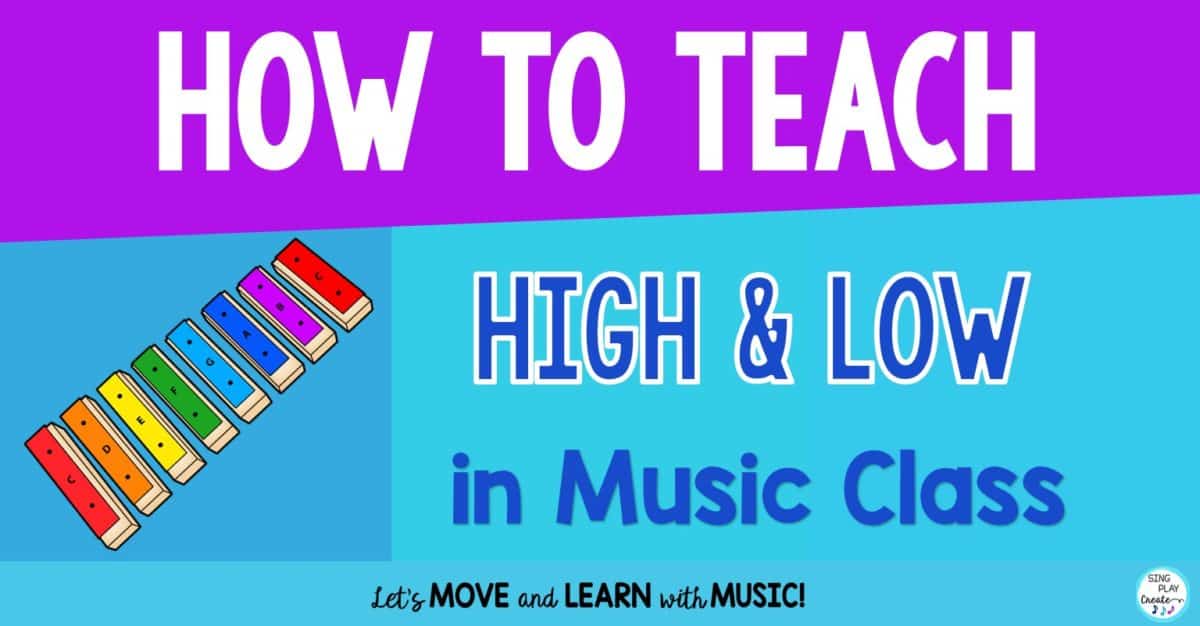
How do you teach high and low to your music class students? I think most music teachers would agree that the best ways to teach high and low keep students engaged in a variety of experiences that create awareness of pitch. Keep reading to learn about the five activities to teach high and low in music class. You’ll find out how to teach high and low in music class and get a new free resource.
If you’re teaching students from grades PreK to 3, you’ll want to begin with teaching High and Low in your very first music activities. Although those terms can be a little tricky to explain (and sometimes a bit confusing to young children), there are lots of ways to help them get the idea of high and low.
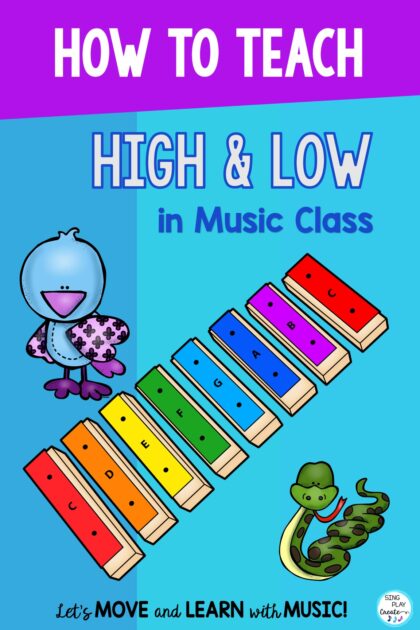
One fun relatable activity is using train songs, chants and movement activities to teach music concepts like HIGH and LOW. Sing Play Create offers a complete Kindergarten and Preschool music lesson bundle with tons of interactive activities like videos, songs, and teaching materials to help your students learn music through experience.
Another fun way to connect music concepts of HIGH/LOW is to use animal friends to help students see and hear high and low pitch.
Students love animals and when they hear the animal sounds, they will be crawling, flying, and hopping through your music lessons.
Take a look at this fun game you can play using the free resource or animal pictures you already have in your classroom. (In the free resource, you’ll find animal sounds in the teaching PowerPoint!)
Birds tweet HIGH,
And cows moo LOW.
Cats meow HIGH
And frogs ribbit LOW.
Can you show me the way the pitch goes?
Dolphins cry HIGH
And lions Roar LOW.
Can you show me the way the pitch goes?
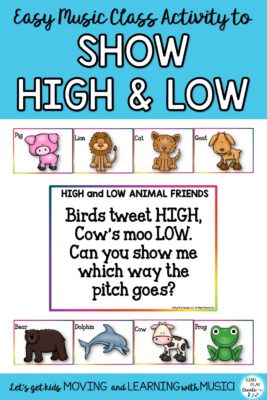
Students love to experiment on xylophones. Just look at the xylophone and you’ll see and hear that the higher the pitch, the smaller the bar and the lower the pitch, the wider the bar.
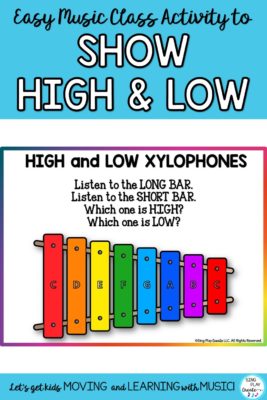
Demonstrate HIGH and LOW Using Instrument Sounds
Students love to pretend to play instruments. Use the high and low activities as part of your instrument unit. Your students will be able to click on the pictures to hear the instrument sounds in the free resource. You may want to find and use some of your favorite classical selections to demonstrate high and low.
HIGH/LOW examples can be found in most operas and musicals. Try using “The Marriage of Figaro” by Mozart.
What about a Flute?
What about a Tuba?
How about a Violin?
How about a String Bass?
Connecting HIGH and LOW through Literature and Activity Songs
Reading a familiar book with your students can help them connect to or deepen the concept of pitch. How about using the favorite folktale “The Three Bears”? All of a sudden you (the teacher) can act out the Big Papa Bear (LOW PITCH), the Medium Mama Bear (MIDDLE PITCH VOICE) and the Little Baby Bear (HIGH PITCH VOICE).
Here’s a classic version of this adorable story.

I love to use Action Songs to help my younger students stay engaged and to “get” the idea of pitch.
I think that the activity song “Gallump Went the Little Green Frog” is an excellent song and activity to teach High and Low in music class.
You can get these posters when you SUBSCRIBE to the Free Resource Library.
One thing I’ve used successfully are vocal exploration activities. That’s why I begin with my Kinders using vocal explorations and movement activities with music and sounds that are High and Low. I’ve created vocal exploration activities for every holiday and theme for the entire school year. They are now available in the Sing Play Create Shop and at my Teachers Pay Teachers store. (Some of them are still be added to our online shop).
The Vocal Explorations Bundle for Music Class is useful for the entire school year. Now includes animated PowerPoints for students to use at smart boards or on the computer. Includes themes and lessons to help your students experiment with and explore their voices while preparing for note reading and developing singing skills, especially HIGH and LOW. Perfect for PreK – 3rd Grade.
RESOURCE INCLUDES:
How to Use Vocal Explorations In Your Music Class Vocal play is an important activity in the music room because it helps students explore and experiment with their voices.
Students experience vocal play as they interact with the animated graphics, create their own vocal explorations, or use puppets, the smart board and participate in the games and activities included in each resource.
The worksheets and graphics provide extension activities to be used in stations, in your sub tub, or for assessment. Imagine using this resource at the beginning of your lessons.
You can use the videos as you take roll, organize activities, and ready for the next lesson.
Perfect for assessing HIGH AND LOW. Interactive and Engaging
Check out the variety of Scarf movement activities at Sing Play Create.
Adorable Animals are waving and swooshing their scarves around to help students move, burn energy, stay focused and get some exercise in during your classes. Cute video with music and scarf moves for your Preschool and Kindergarten Music, P.E. and regular ED classes. Many ways to use this engaging scarf activity, like a music lesson on high/low, fast/slow, a brain break or for creative movement time. The actions are directional words and students will love coloring the action words and tracing the scarf paths.
Try using a variety of creative movement activities while evaluating your students on their ability to show HIGH and LOW in music class.
You’ll find using body movements, scarves, props, worksheets with pictures and to demonstrate and assess will give your kinesthetically inclined students opportunities to excel and provide a channel for your student’s energy.

How do you teach high and low to your music class students? There are so many different ways and tons of resources to keep students engaged in a variety of experiences that create awareness of pitch.
I hope you got some ideas from this article on how to teach high and low in music class.

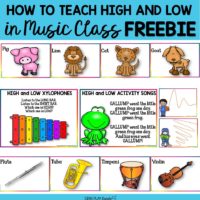
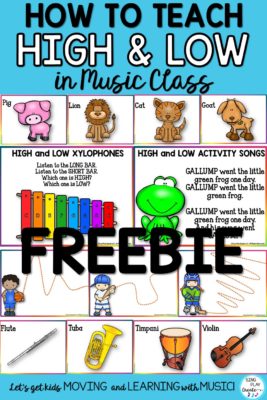

Hi there! I’m Sandra, one of the authors behind Sing Play Create. My goal is to provide teachers with interactive resources and activities to improve the effectiveness of their teaching and enhance student learning.
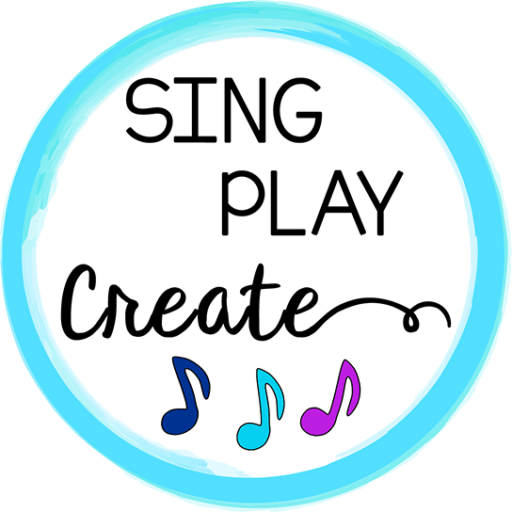
© 2022 Sing Play Create. All Rights Reserved.